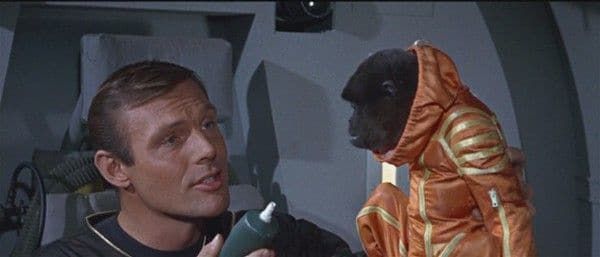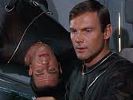Eye For Film >> Movies >> Robinson Crusoe On Mars (1964) Film Review

Mars, 1964. In some ways it's very close to the Mars we know today. Scenes filmed in death valley show us the familiar dun-coloured slopes, the pale, salmon-tinted sky; they conjure up that sense of emptiness, the red planet as a desert island in space. In other ways, it's much more alien. Blasts of fire shoot up unexpectedly from what might be underground methane deposits Red weed grows in secret caves. We have seen this Mars somewhere else. In its turn, it has scrutinised and studied us, perhaps almost as narrowly as a man with a microscope might scrutinise the transient creatures that swarm and multiply in a drop of water.
Designer Al Nozaki came to Robinson Crusoe On Mars direct from Byron Haskin's take on War Of The Worlds and he brought a little something with him. There's no rout of mankind here, however, as it only has two representatives, and one of them, the spaceship colonel played by Adam West (who will keep you waiting for a punchline that never arrives), does not survive the opening 20 minutes. This leaves Commander Kit Draper (Paul Mantee) alone on the Martian surface except for a monkey named Mona (Barney the Woolly Monkey). Between them they have to find out how to get oxygen, water and food - how to survive in a hostile new environment.

Though in many ways it's surprisingly faithful to Daniel Defoe's Earthbound original novel, this film never generates the same feeling of loneliness - there's just too much going on and Kit never seems to doubt himself. Mantee was chosen for his resemblance to legendary astronaut Alan Shepard and there's just a bi too much all-American military confidence to the affair. That said, it was never intended to be an arthouse film and the faster pacing gives it considerably more audience appeal. It also does some interesting things with the character of Friday, in this case a humanoid alien (played by soon-to-be-Klingon Victor Lundin) which subverts many of the more problematic aspects of the original, at least for viewers who are paying attention.
The film was praised in its time for its adherence to scientific reality, and even though it gets a few things wring, this approach means it retains a groundedness that many such tales lack. It's not always tightly plotted (Mona is frequently forgotten about when she might create narrative difficulty) but it packs a lot in, with a tour of the planet that makes room for lots of different scientific discussion after Kit (with a stunning display of Colonial-style smugness) teaches Friday to speak English. There's lots to appeal to fans of adventure stories and the film has a distinctive visual style that adds to its character, with a mixture of animation and model work that works to great effect. It wasn't a big success on release but it's a fascinating example of the science fiction cinema of the time and it's well worth a look.
Reviewed on: 21 Nov 2015

















